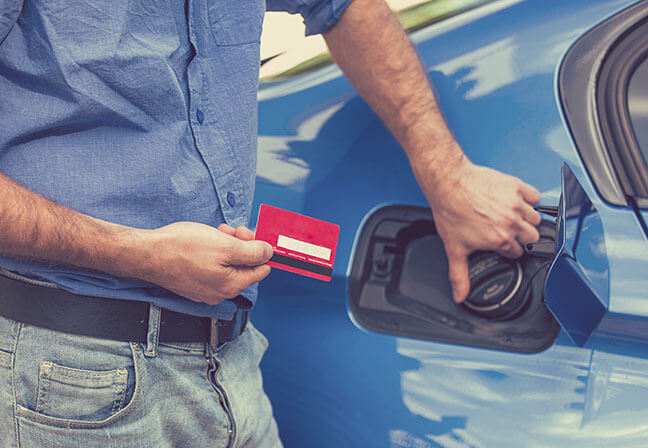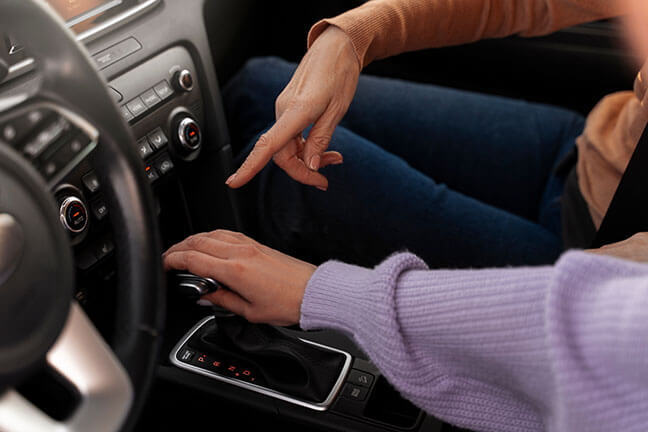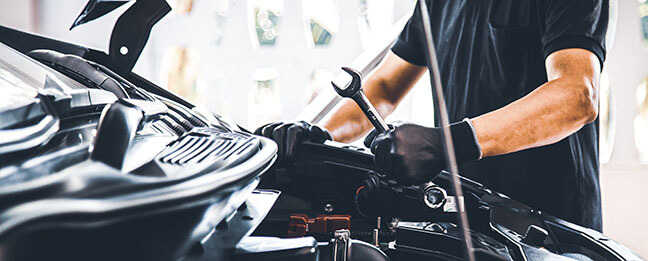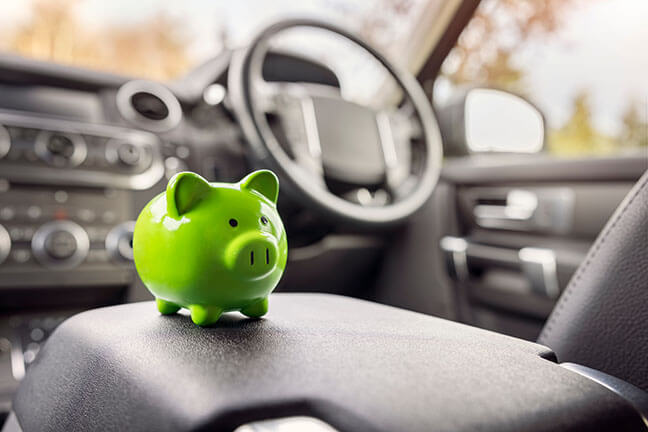Filling up your gas tank, these days feels like watching your hard-earned dollars vanish into thin air. With the national average gas price hovering around $3.50 – $5.50 per gallon, drivers are desperate for ways to spend less at the pump.
The good news? You can stretch your gas budget further with simple tips to save money on gas like using gas apps, improving driving habits, performing maintenance, and joining rewards programs. This listicle outlines 13 proven fuel savings tips to save money on gas that will have you smiling instead of cringing during your next fill-up. Keep reading to start saving!
Use Gas Comparison Apps to Check Gas Prices
Apps like GasBuddy, Waze, and Google Maps make locating the cheapest nearby gas stations a breeze. Simply input your location and fuel type, and view a list comparing prices across stations.
GasBuddy
Gas Buddy provides comparisons of the cheapest gas prices and a debit-type card offering additional savings when used to pay for fuel. You can also build up savings when making everyday purchases at retail stores.
GasBuddy also lets you view price heat maps showing cost variations and outages by region.
Pay with Cash Instead of Credit
Most gas stations offer discounted pricing for cash payments since they avoid processing fees for credit transactions. The difference in gas expenses can range from 5 to 15 cents per gallon.
Some stations provide the same lower cash price for debit payments. Just know skimmers are more common on debit cards. Going inside to prepay cash avoids this risk while still scoring you the lowest price.
Get Free Gas Cards
Whether you’re looking for free gas cards or free gas vouchers there are several places that can actually help you get FREE gas. Check out our article on Free Gas Cards in order to find out exactly how .

Join Fuel Rewards Programs
Major gas brands like Shell, Exxon, and BP offer free rewards programs that save you money at the pump. Grocery stores like Kroger also offer fuel perks when you spend a certain amount on groceries.
These programs give you discounts of 5-20 cents per gallon. Make sure to compare membership fees if any against potential gas savings. The more you drive and pump, the more worthwhile rewards become.
Upside – Gas Rewards App
Upside is a gas station and restaurant app that pays you when using one of the vendors. You’ll get money for each gallon of gas you purchase. Its search feature will show you participating stations in your area and how much per gallon you’ll get credited to your account.
You can have the money deposited in your account or turned into a gas card. You’ll receive bonus money for every gallon for friends who sign up through your referral code.
Download the Upside app and save money on gas and earn some extra spending cash today.
Save with Gas Rewards Credit Cards
Gas credit cards allow drivers to earn cashback, points, or miles on fuel purchases. Many cards offer bonus rewards specifically for gas station transactions.
For example, the Costco Anywhere Visa Card by Citi provides 4% cash back on eligible gas purchases up to $7,000 per year. Over 12 months, that could add up to $280 in gas rewards.
The Sam’s Club Mastercard offers 5% cash back on gas purchases for the first $6,000 in spending annually. That equates to a maximum of $300 per year in gas rewards.
Your favorite gas station credit card
Many gas stations offer their own credit cards where you can earn points or save money on gas every time you fill up. Check if you are eligible and if there are any annual fees that would offset the savings you would receive from using their card.
When using a gas rewards card, make sure to pay off the balance each month to avoid accumulating interest charges that offset savings. Also, compare any annual fees against expected rewards.
Gas cards provide significant savings for frequent fill-ups. But even non-gas-specific rewards cards can offer bonus categories on gas quarterly or at certain merchants. Shop around for the best card for your spending and driving habits.

Improve Your Driving Habits and Increase Fuel Efficiency
Boost Your MPG with Smart Driving Habits
How you drive significantly impacts your vehicle’s miles per gallon and fuel costs. By modifying habits like speed, acceleration, idling, weight, and trip planning, you can reduce fuel consumption and extend the life of each tank of gas.
Obey the Speed Limit
Speeding rapidly reduces MPG due to increased wind resistance. According to the Department of Energy, every 5 MPH over 50 MPH reduces fuel economy by 7% on average. For example, driving 75 MPH uses 15% more gas than cruising at 70 MPH. At 60 MPH, fuel economy improves by 14% over 75 MPH speeds.
The impact increases exponentially the faster you go especially on larger SUVs as the vehicle’s wind resistance is greater. Easing up on the pedal and setting your cruise control to the speed limit maximizes MPG without sacrificing too much time.
Accelerate and Brake Gradually
Sudden acceleration and braking forces the engine to work harder, using more fuel. Smooth gradual acceleration and beginning braking early maximize momentum and keep the engine operating efficiently.
Coasting to red lights and stop signs in particular is fuel efficient and saves gas wasted by hard braking at the last minute. Gentle smooth acceleration from stops maintains momentum just as well without the rush of fuel needed for jackrabbit starts.
Limit Excessive Idling
Idling gets 0 MPG. Sitting still with the engine running for over 10 seconds uses more fuel than turning off the car and restarting. Limit idling in drive-thrus, at long red lights, waiting for passengers, etc.
Idling uses anywhere from 1/5 to 1/2 gallon of gas per hour depending on engine size. The brief restart only uses about 10 seconds worth of wasted gas. Modern cars also need little time idling to warm up before driving.
Plan Routes in Advance
Picking efficient routes avoids unnecessary driving and minimizes stop-and-go traffic which burns gas quicker. Map routes with the fewest lights, congestion, hills, and merging. Combining multiple errands also eliminates extra trips.
Shed Excess Vehicle Weight
An extra 100 lbs. reduces fuel economy by 1% on average. Remove unnecessary cargo, racks, bins, etc. when not needed. Lightening your load helps the engine perform more efficiently. Avoid using a roof rack whenever possible.
Careful of the Air Conditioner
A vehicle’s air conditioning system places extra load on the engine which reduces fuel efficiency, especially in stop-and-go driving. Air conditioning can decrease gas mileage by up to 25% based on Department of Energy studies.
This impact results from the A/C compressor activating which increases aerodynamic drag. The effect becomes worse at low speeds compared to highway cruising. Turning the air down, using vent settings, and parking in the shade can help offset the mileage loss and save gas.

Increase Gas Mileage – Perform Regular Maintenance
Simple maintenance like oil changes, new air filters, tire rotation, fluid checks, and properly inflated tires improve your vehicle’s MPG. Underinflated tires alone can reduce fuel economy by 0.2% for every PSI drop!
Helpful Tip: You can find your car’s optimum tire pressure chart on the driver’s side door. You don’t have to bend over trying to read it off the tires.
Replacing worn spark plugs, fixing engine issues, and inspecting brakes and transmission all optimize efficiency and better gas mileage. Don’t ignore the check engine light! Service your vehicle regularly to keep your MPG high.
Reduce Idling and Warmup Times
Idling for over 10 seconds uses more fuel than restarting your engine. Modern cars also only need about 30 seconds of warmup idling when cold. Turn off your car while waiting or in drive-thrus to conserve gas.
Check if Your Vehicle Requires Premium Gas
When gas prices are high, drivers naturally look for ways to spend less at the pump. One question that comes up is whether you truly need to use premium gasoline recommended for your vehicle.
The higher 91-93 octane grades cost 20-30 cents more per gallon on average. That adds up quickly if your car calls for premium fuel. However, some models may actually run just fine on mid-grade 89 octane gas despite recommendations.
Octane rating relates to the fuel’s resistance to engine knocking and pre-ignition. Premium gas is intended for high-compression, performance engines. But many mainstream models today list premium gas in the owner’s manual simply because the engine is higher compression than older versions.
Keep an eye on your gas mileage and vehicle’s fuel efficiency when you use the mid-grade fuel. If there is no noticeable difference, then you get to enjoy lower gas prices and save money every time you fill up!
The only way to know for sure if you can get by on mid-grade is to try it out. Listen for knocking or pinging as you accelerate. If the engine sounds smooth, your car is likely fine with 89 octane. Premium is recommended for maximum performance, but not always required.
Saving 20 cents per gallon by dropping one grade down could save you over $100 annually—that more than offsets the cost of an occasional tank of premium for optimal engine cleaning.
Be cautious with older, high-mileage engines though. The accumulation of carbon deposits over time raises compression, making premium gas more critical. When in doubt, consult your mechanic to see if cheaper gas may work for your car.

Bonus Tip: Enroll in Lifeline to Get FREE Wireless Service
Lower your expenses further by using Lifeline and ACP to get free smartphone service through providers like EASY Wireless. If you qualify by participating in programs like Medicaid or SNAP, or based on your income level, you get Unlimited Talk, Text, and Data at no cost.
That’s $600 or more in annual savings! With EASY Wireless, you can even keep your number and device. Why not cut another bill to maximize funds for priorities like gas and groceries?
Learn more about these amazing programs at EASY Wireless.
Get Started on Improving Your Car’s Fuel Economy and Saving Money
Using gas comparison apps, changing driving habits, performing maintenance, joining rewards programs, and eliminating bills through Lifeline and ACP are just a few ways you can keep more money in your pocket when gas prices are high. Apply 2-3 of these money-saving tips and you’ll immediately notice the savings during fill-ups at the gas pump. Don’t let gas costs tank your budget!


